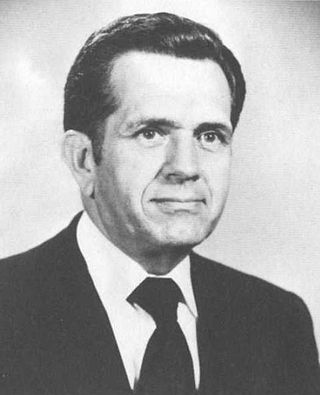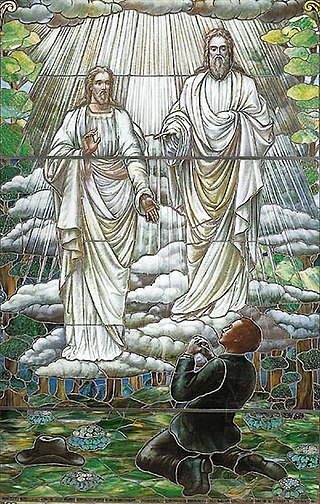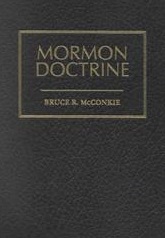
Boyd Kenneth Packer was an American religious leader and educator who served as president of the Quorum of the Twelve Apostles of the Church of Jesus Christ of Latter-day Saints from 2008 until his death. He also served as the quorum's acting president from 1994 to 2008 and was an apostle and member of the Quorum of the Twelve from 1970 until his death. He served as a general authority of the church from 1961 until his death.
The law of chastity is a moral code defined by the Church of Jesus Christ of Latter-day Saints. According to the church, chastity means that "sexual relations are proper only between a man and a woman who are legally and lawfully wedded as husband and wife." Therefore, abstinence from sexual relations outside of marriage, and complete fidelity to one's spouse during marriage, are required. As part of the law of chastity, the church teaches its members to abstain from adultery and fornication.

Affirmation: LGBTQ Mormons, Families, & Friends is an international organization for individuals who identify as gay, lesbian, transgender, bisexual, queer, intersex, or same-sex attracted, and their family members, friends, and church leaders who are members or former members of the Church of Jesus Christ of Latter-day Saints.

The basic beliefs and traditions of the Church of Jesus Christ of Latter-day Saints have a cultural impact that distinguishes church members, practices and activities. The culture is geographically concentrated in the Mormon Corridor in the United States, and is present to a lesser extent in many places of the world where Latter-day Saints live.
Sexuality has a prominent role within the theology of the Church of Jesus Christ of Latter-day Saints. In its standards for sexual behavior called the law of chastity, top LDS leaders bar all premarital sex, all homosexual sexual activity, the viewing of pornography, masturbation, and overtly sexual kissing, dancing, and touch outside marriage. LDS Leaders teach that gender is defined in premortal life, and that part of the purpose of mortal life is for men and women to be sealed together in heterosexual marriages, progress eternally after death as gods together, and produce spiritual children in the afterlife. The church states that sexual relations within the framework of monogamous opposite-sex marriage are healthy, necessary, and approved by God. The LDS denomination of Mormonism places great emphasis on the sexual behavior of Mormon adherents, as a commitment to follow the law of chastity is required for baptism, adherence is required to receive a temple recommend, and is part of the temple endowment ceremony covenants devout participants promise by oath to keep.
The Young Women is a youth organization of the Church of Jesus Christ of Latter-day Saints. The purpose of the Young Women organization is to help each young woman "be worthy to make and keep sacred covenants and receive the ordinances of the temple."

All homosexual sexual activity is condemned as sinful by the Church of Jesus Christ of Latter-day Saints in its law of chastity, and the church teaches that God does not approve of same-sex marriage. Adherents who participate in same-sex sexual behavior may face church discipline. Members of the church who experience homosexual attractions, including those who self-identify as gay, lesbian, or bisexual remain in good standing in the church if they abstain from same-sex marriage and any homosexual sexual activity or sexual relationships outside an opposite-sex marriage. However, all people, including those in same-sex relationships and marriages, are permitted to attend the weekly Sunday meetings.

The Church of Jesus Christ of Latter-day Saints focuses its doctrine and teaching on Jesus Christ; that he was the Son of God, born of Mary, lived a perfect life, performed miracles, bled from every pore in the Garden of Gethsemane, died on the cross, rose on the third day, appeared again to his disciples, and now resides, authoritatively, on the right hand side of God. In brief, some beliefs are in common with Catholics, Orthodox and Protestant traditions. However, teachings of the LDS Church differ significantly in other ways and encompass a broad set of doctrines, so that the above-mentioned denominations usually place the LDS Church outside the bounds of orthodox Christian teaching as summarized in the Nicene Creed.

"To Young Men Only" is a sermon delivered by Latter-day Saint apostle Boyd K. Packer on October 2, 1976, at the priesthood session of the 146th Semiannual General Conference of the Church of Jesus Christ of Latter-day Saints. The sermon is addressed to young men of the Aaronic priesthood and discusses issues of human sexuality, puberty, and morality. From 1980 to 2016, the sermon was published as a pamphlet by the LDS Church. It has been criticized in several publications for allegedly encouraging violence against homosexuals. In 2016, the church discontinued the pamphlet.
On many occasions spanning over a century, leaders of the Church of Jesus Christ of Latter-day Saints have taught that adherents should not masturbate as part of obedience to the code of conduct known as the law of chastity. This denomination within Mormonism places great emphasis on the sexual behavior of Mormon adherents as a commitment to follow the law of chastity is required for baptism, and adherence is required to receive a temple recommend, and is part of the temple endowment ceremony covenants devout participants promise by oath to keep. A 2011 church manual quotes former church president Spencer W. Kimball who taught that the law of chastity includes "masturbation ... and every hidden and secret sin and all unholy and impure thoughts and practices." Before serving full-time missions, young adults are required to abandon the practice as it is believed to be a gateway sin that dulls sensitivity to the guidance of the Holy Ghost. The first recorded public mention of masturbation by a general church leader to a broad audience was in 1952 by apostle J. Reuben Clark, and recent notable mentions include in 2016, 2019, and 2021.
Steven J. Lund is an American executive, attorney, and has been the 23rd Young Men General President of the Church of Jesus Christ of Latter-day Saints since April 2020.

Because of its ban against same-sex sexual activity and same-sex marriage the Church of Jesus Christ of Latter-day Saints has a long history of teaching that its adherents who are attracted to the same sex can and should attempt to alter their feelings through righteous striving and sexual orientation change efforts. Reparative therapy is the pseudoscientific practice of attempting to change an individual's sexual orientation from homosexual or bisexual to heterosexual, or their gender identity from transgender to cisgender using psychological, physical, or spiritual interventions. There is no reliable evidence that such practices can alter sexual orientation or gender identity, and many medical institutions warn that conversion therapy is ineffective and potentially harmful.
This is a timeline of LGBT Mormon history in the 1950s, part of a series of timelines consisting of events, publications, and speeches about LGBTQ+ individuals, topics around sexual orientation and gender minorities, and the community of members of the Church of Jesus Christ of Latter-day Saints. Although the historical record is often scarce, evidence points to queer individuals having existed in the Mormon community since its beginnings. However, top LDS leaders only started regularly addressing queer topics in public in the late 1950s. Since 1970, the LDS Church has had at least one official publication or speech from a high-ranking leader referencing LGBT topics every year, and a greater number of LGBT Mormon and former Mormon individuals have received media coverage.
This is a timeline of LGBT Mormon history in the 1960s, part of a series of timelines consisting of events, publications, and speeches about LGBTQ+ individuals, topics around sexual orientation and gender minorities, and the community of members of the Church of Jesus Christ of Latter-day Saints. Although the historical record is often scarce, evidence points to queer individuals having existed in the Mormon community since its beginnings. However, top LDS leaders only started regularly addressing queer topics in public in the late 1950s. Since 1970, the LDS Church has had at least one official publication or speech from a high-ranking leader referencing LGBT topics every year, and a greater number of LGBT Mormon and former Mormon individuals have received media coverage.
This is a timeline of LGBT Mormon history in the 1970s, part of a series of timelines consisting of events, publications, and speeches about LGBTQ+ individuals, topics around sexual orientation and gender minorities, and the community of members of the Church of Jesus Christ of Latter-day Saints. Although the historical record is often scarce, evidence points to queer individuals having existed in the Mormon community since its beginnings. However, top LDS leaders only started regularly addressing queer topics in public in the late 1950s. Since 1970, the LDS Church has had at least one official publication or speech from a high-ranking leader referencing LGBT topics every year, and a greater number of LGBT Mormon and former Mormon individuals have received media coverage.
This is a timeline of LGBT Mormon history in the 1990s, part of a series of timelines consisting of events, publications, and speeches about LGBTQ+ individuals, topics around sexual orientation and gender minorities, and the community of members of the Church of Jesus Christ of Latter-day Saints. Although the historical record is often scarce, evidence points to queer individuals having existed in the Mormon community since its beginnings. However, top LDS leaders only started regularly addressing queer topics in public in the late 1950s. Since 1970, the LDS Church has had at least one official publication or speech from a high-ranking leader referencing LGBT topics every year, and a greater number of LGBT Mormon and former Mormon individuals have received media coverage.
This is a timeline of LGBT Mormon history in the first decade of the 2000s, part of a series of timelines consisting of events, publications, and speeches about LGBTQ+ individuals, topics around sexual orientation and gender minorities, and the community of members of the Church of Jesus Christ of Latter-day Saints.
This is a timeline of LGBT Mormon history in the 2010s, part of a series of timelines consisting of events, publications, and speeches about LGBTQ+ individuals, topics around sexual orientation and gender minorities, and the community of members of the Church of Jesus Christ of Latter-day Saints.

Homosexuality has been publicly discussed by top leaders in the Church of Jesus Christ of Latter-day Saints —Mormonism's largest denomination—since the late 1800s. The frequency of teachings on same-sex sexual activity increased starting in the late 1950s. Most discussion focuses on male homosexuality and rarely mentions lesbianism or bisexuality. Below is a timeline of notable speeches, publications, and policies in the LDS church on the topic of homosexuality.









